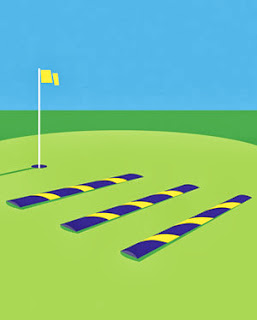Yesterday I read what I believe to be a great article written by the editor of Golf Digest, Jerry Tarde. I often think that our fairway HOC (height-of-cut) is too short resulting in very tight lies and making it even more difficult for the mid to high handicappers to hit from. We mow them at .45". The HOC of our "first-cut" of rough is .75" and seems to be the preferred landing area of many golfers. We cut our rough lower this year than ever before, 1.5" throughout the season to be exact and the feedback from golfers has been very positive.
I think it's time to revisit our HOCs this winter and make some adjustments for next year as the majority of our golfers are not in lower handicap range. That's just one example of how we can make our course a bit "easier" and certainly more enjoyable for the majority instead of continually conditioning it for the minority. I think we can all agree that this game is hard enough as it is with the things that we cannot control so why not offer playing conditions that are more suitable for scoring. Improved scoring = more enjoyment and yes, improved pace of play!
Okay, so here is the article that I was referring to. Give it a quick read with an open mind and I assure you it will make a lot of sense...
In Praise Of Longer Grass
 |
| illustration by Ben Wiseman |
The hardest shot in golf isn't the long bunker shot anymore.
The hardest shot in golf is any hybrid, iron or even wedge played from
the middle of the fairway with a slightly downhill lie to an elevated
green. It's so darn hard because the fairway is probably cut to linoleum
height. Golfers struggle these days not so much with hitting it long or
straight but with getting it airborne.
Today's tight lies conspire against that enjoyment. Closely mowed grass
is easier for tour pros to play from but harder for average hackers like
us. That's why I'm happy when my ball lands in the first cut of rough
so I have a little cushion under my shot. Tight lies also diminish
short-game shotmaking. We see more golfers putting from long distances
off the green instead of playing artful wedges and run-ups.
I was making this case to Mike Davis, executive director of the United
States Golf Association, just before the pros played Merion in June.
Steve Smyers, an architect, had told me the fairway height at Merion for
the 1971 Open was one inch. When I repeated that to Davis, he paused
and said the planned fairway height for this year's Open was .26 inches.
A couple of weeks later, Davis surprisingly reversed himself and
announced Merion's fairway height at .45 inches.
"We had been trying to message about green speeds that they had just
gotten too fast," Davis said, "and they cause agronomic and
architectural problems. I actually think they cause nerve problems. It's
why some people have gone to anchoring. And fairway height, again, it
causes agronomic problems. The average golfer simply can't get the ball
up, and they have trouble pitching it, too. So the reason we went to
almost half an inch this year was me saying, 'Listen, I think it's the
right statement for golf.' And we're going to do it again next year in
the Open at Pinehurst."
The Stimpmeter was invented by Edward Stimpson in the 1930s as a device
for measuring green speeds, but it was not adopted by the USGA until
1977, whereupon the USGA field staff was commissioned to measure 581
courses nationwide to benchmark the speed of American greens. Here is a
sampling of what was found:
Cypress Point: 7 feet, 8 inches
Pebble Beach: 7-2
San Francisco Golf Club: 6-5
Augusta National: 7-11
Medinah: 7-8
Congressional: 6-4
Oakland Hills: 8-5
Pinehurst No. 2: 6-10
Pine Valley: 7-4
Winged Foot: 7-5
Shinnecock Hills: 7-2
Merion: 6-4
Harbour Town: 5-1
Oakmont: 9-8
Cypress Point: 7 feet, 8 inches
Pebble Beach: 7-2
San Francisco Golf Club: 6-5
Augusta National: 7-11
Medinah: 7-8
Congressional: 6-4
Oakland Hills: 8-5
Pinehurst No. 2: 6-10
Pine Valley: 7-4
Winged Foot: 7-5
Shinnecock Hills: 7-2
Merion: 6-4
Harbour Town: 5-1
Oakmont: 9-8

No comments:
Post a Comment